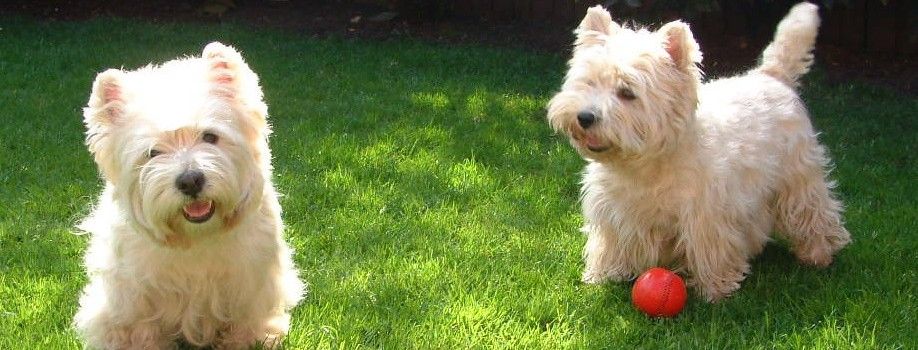Laurie's Blogs.
Mar 2020
Guest Blog - Laser for Pulmonary Fibrosis

by Peter A. Jenkins, MBA
I've received a few questions about Westie lung disease in the past few years. There's even a Facebook group devoted to it, and a lot of talk about treating it with laser therapy; they seem to believe that it's only effective with Class 4 laser (which is plain wrong!). So, a lot of animals that could potentially be helped are probably not being treated. Unfortunately, despite the popularity of the treatment over recent years, no clinical data have yet been published.
Looking at the work that has been done vis-a-vis laser therapy/photobiomodulation for fibrosis, there's one published study (Brochetti 2017) using LED therapy (660 nm 100 mW) to treat an experimental model of lung fibrosis in mice, another (Oliveira 2012) using laser therapy (780 nm 30 mW) for renal interstitial fibrosis, and another (Oliveira 2013) using laser (830 nm 35 mW) for cirrhosis; all showed promising results. There's also plenty of evidence for laser reducing scar tissue in skin and muscle. And, underlying all of these, there's plenty of mechanistic work showing modulation by photobiomodulation of the various cytokines and growth factors that produce fibrotic tissue. Following below are photos of some relevant posters from the 2018 World Association for Laser Therapy congress.
The protocol I've worked up for use with our SpectraVET PRO2 and 810-2000 (4 x 500mW diodes – 810nm) is pretty straight forward: Set the control unit to CW & 90 secs, and treat multiple sites over the lungs and trachea. Treat at least twice (ideally 3-4) in the first week, at least once (ideally 2-3 times) in the second week, and then once per week for another 2-4 weeks. Start tapering off treatments to once every 9-10 days, then once every two weeks, and so on until you reach the longest effective interval (LEI), then maintain.
Things to consider changing to optimize the outcome for a particular patient, or if the patient's response plateaus or starts to regress, would be to e.g. increase the frequency of treatment sessions (then taper off again until you reach the LEI), and/or use a pulsing frequency instead of CW and increase the treatment duration per site accordingly (i.e. typically double the laser time).
The treatment durations I've seen mentioned with Class 4 lasers run up to 25 minutes, but I can't see any need to treat for that long; I'd expect the majority of treatments to range from 4.5-to-9 minutes, and in some cases, perhaps, up to a maximum of 15 minutes.
Based on reports back from other customers who have treated Westies with this protocol (or similar, depending up the probe(s) they have), you've got a good or better chance of seeing some improvement.
References:
1.Brochetti RA, Leal MP, Rodrigues R, et al. Photobiomodulation therapy improves both inflammatory and fibrotic parameters in experimental model of lung fibrosis in mice. Lasers Med Sci. 2017;32(8):1825–1834.
2.Oliveira FA, Moraes AC, Paiva AP, et al. Low-level laser therapy decreases renal interstitial fibrosis. Photomed Laser Surg. 2012;30(12):705–713.
3.Oliveira-Junior MC, Monteiro AS, Leal-Junior EC, et al. Low-level laser therapy ameliorates CCl4-induced liver cirrhosis in rats. Photochem Photobiol. 2013;89(1):173–178.
Author’s Biography
Peter A. Jenkins, MBA, began his exciting and ongoing adventure in the world of laser therapy & photobiomodulation in Australia in 1996. His technical background includes the specification and development of laser devices for safety, reliability, affordability and efficacy, and he is driven to create technologies that enable practitioners to optimize their patients’ clinical outcomes. A passionate educator, and co-author of a number of peer-reviewed articles, Peter sees market education as the key to improving standards in the laser therapy/photobiomodulation industry and holding manufacturers and marketers accountable for the claims they make.
Professional Positions
•Spectra-Medics Pty Ltd (Founder, Managing Director)
•SpectraVET, Inc. (Co-Founder, Dir. Education & Technology)
•Immunophotonics, Inc. (Co-Founder, Technology Advisor)
Honorary Positions
•Co-Founder & Council Member, Australian Medical Laser Association Inc
•Co-Founder, Co-Editor, The Annals of Laser Therapy Research
•Committee Member, Standards Australia HE3-12/003 (Medical Laser Safety)
•Peer Reviewer, Photomedicine & Laser Surgery
•Peer Reviewer, Lasers in Surgery & Medicine
•Peer Reviewer, Photochemistry & Photobiology
•Peer Reviewer, Dose-Response
•Past President (1998-9), Hornsby and District Chamber of Commerce & Industry Inc
Qualifications
•Master of Business Administration (University of Western Sydney) 1997
•Avionics Technician (Royal Australian Air Force) 1992
•Instrument Fitter (Royal Australian Air Force) 1984


